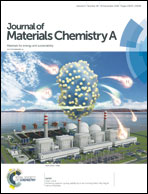Construction of an efficient hole migration pathway on hematite for efficient photoelectrochemical water oxidation†
Abstract
Hematite is a prototypical photoanode material that has recently piqued great interest, but fails to deliver the expected performance. The most pronounced disadvantage that plagues the promises held by hematite is its low charge separation efficiency and poor conductivity. In this study, we constructed an efficient hole migration pathway by integrating the co-catalyst (NiOOH) onto the homojunction structured Fe2O3 coating on F-doped α-Fe2O3 nanorods (NiOOH/Fe2O3/F-Fe2O3 NRs). The resulting photoanode exhibited higher photocurrent density (3.4-fold higher than pristine Fe2O3) and lower onset potential (0.61 VRHE) than most reported hematite-based photoanodes. Detailed physical characterization and electrochemical experiments results reveal that the origin of such superior photoelectrochemical water oxidation performance is due to F-doping, built-in field formation and efficient hole extraction. This newly designed photoanode fulfils the requirements of low surface trapping sites, high conductivity, efficient charge separation and injection efficiency. These findings may open a new avenue of fabricating various efficient homojunction photoanodes for practical PEC water splitting.



 Please wait while we load your content...
Please wait while we load your content...